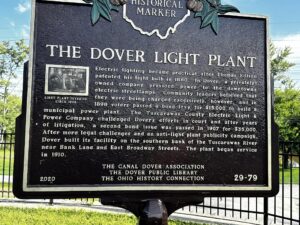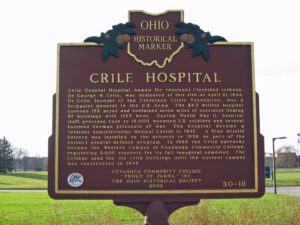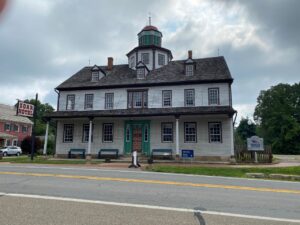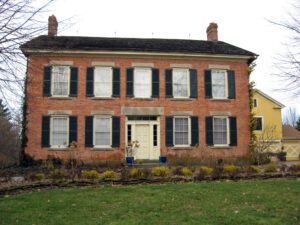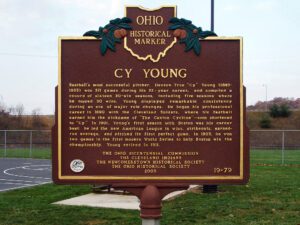, OH
Electric lighting became practical after Thomas Edison patented his light bulb in 1880. In Dover, a privately-owned company provided power to the downtown’s electric streetlamps. Community leaders believed that they were being charged excessively, however, and in 1898 voters passed a bond levy for $15,000 to build a municipal power plant. The Tuscarawas County Electric Light & Power Company challenged Dover’s efforts in court and after years of litigation, a second bond issue was passed in 1907 for $35,000. After more legal challenges and an anti-light plant publicity campaign, Dover built its facility on the southern bank of the Tuscarawas River near Bank Lane and East Broadway Streets. The plant began service in 1910 and, with the Northern Ohio Traction & Light Company, supplied electricity to Dover.
, OH
Crile General Hospital, named for renowned Cleveland surgeon, Dr. George W. Crile, was dedicated at this site on April 21, 1944. Dr. Crile, founder of the Cleveland Clinic Foundation, was a brigadier general in the U.S. Army. The $4.5 million hospital covered 153 acres and contained seven miles of corridors linking 87 buildings with 1725 beds. During World War II, hospital staff provided care to 15,000 wounded U.S. soldiers and several hundred German prisoners of war. The hospital became a Veterans Administration Medical Center in 1945. A Nike missile battery was installed on the grounds in 1956 as part of the nation’s general defense program. In 1966 the Crile barracks became the Western Campus of Cuyahoga Community College, registering 3,000 students for its fall inaugural semester. The College used the old Crile buildings until the current campus was constructed in 1975.
, OH
The Ohio-Erie Canal was built between 1825 and 1832 and extended 308 miles from Lake Erie at Cleveland to the Ohio River at Portsmouth. The greatest engineering achievement in Ohio up to that time, the canal gave the state’s farmers and merchants much greater access to goods and markets and was instrumental in the young state’s rapid growth. Lockbourne was a focal point of activity on the canal with its staircase of eight lift locks (numbered 23 through 30), two canal basins, and junction with the Columbus Feeder. Locke Meadow Park encompasses the remnants of Lock 30 and the Big Walnut Creek guard lock, which prevented flood water from entering the main canal. The Lock Tender’s house was located adjacent to Lock 30.
, OH
The Ohio-Erie Canal was built between 1825 and 1832 and extended 308 miles from Lake Erie at Cleveland to the Ohio River at Portsmouth. The greatest engineering achievement in Ohio up to that time, the canal gave the state’s farmers and merchants much greater access to goods and markets and was instrumental in the young state’s rapid growth. Lockbourne was a focal point of activity on the canal with its staircase of eight lift locks (numbered 23 through 30), two canal basins, and junction with the Columbus Feeder. Locke Meadow Park encompasses the remnants of Lock 30 and the Big Walnut Creek guard lock, which prevented flood water from entering the main canal. The Lock Tender’s house was located adjacent to Lock 30.
, OH
Zoar Separatists built the hotel in 1833 to accommodate overflow travelers from their original Ohio & Erie Canal inn. The hotel proved an economic boon to the Zoar community, but, by bringing the outside world into Zoar, ultimately became a source of discontent for members. During its heyday, the Zoar Hotel catered to curiosity-seekers, visiting artists, and families escaping the summer heat of nearby cities. Notable guests included Marcus Hanna and President William McKinley. The original structure was enlarged several times, including the now demolished 1892 Queen Anne addition which doubled the accommodations. By the mid-twentieth century, the hotel remained open as a popular restaurant with Rathskeller bar until closing to the public in July 1983. The exterior was restored by the Ohio History Connection in 2001-2002.
, OH
Born in Jefferson, Ohio, Theodore E. Burton graduated from Oberlin College and became a prominent Cleveland attorney. He was elected to Congress in 1888 and served from 1889-91, 1895-1909, and 1921-28. He was elected U.S. Senator in 1908 and 1928 and was a leading contender for the U.S. Presidency in 1916. Due to his work in saving Niagara Falls from development and his opposition to wasteful waterways projects, President Theodore Roosevelt appointed Burton chairman of the Inland Waterways Commission in 1907 and the National Waterways Commission in 1909. Burton is credited with pushing legislation through Congress that authorized the construction of the Panama Canal and negotiating agreements to ensure its neutrality. He lobbied to fight wasteful spending and influence of big business and sponsored the Sherman Anti-Trust Act of 1890. As president of the American Peace Society, Burton hosted the First World Conference on International Justice in Cleveland in 1928, attended by 13,000, including world leaders.
, OH
Baseball’s most successful pitcher, Denton True “Cy” Young (1867-1955) won 511 games during his 22-year career, and compiled a record of sixteen 20-win seasons, including five seasons where he topped 30 wins. Young displayed remarkable consistency during an era of major rule changes. He began his professional career in 1890 with the Cleveland Spiders, where his fastball earned him the nickname of “The Canton Cyclone”–soon shortened to “Cy.” In 1901, Young’s first season with Boston was his career best: he led the new American League in wins, strikeouts, earned-run average, and pitched its first perfect game. In 1903, he won two games in the first modern World Series to help Boston win the championship. Young retired in 1911.
, OH
In 1912, an endowment of $6,000 from Andrew Carnegie made it possible for the Bristol Public Library to become a reality. Four years earlier, the newly organized Bristol Library Association, headed and promoted by retired Judge Norman A. Gilbert, had established a subscription book service at the Congregational Church in Bristolville with books loaned from the state library. The Bristol Board of Education appointed a six-member Library Board of Trustees and a one mill levy provided financial support. Charles C. Thayer and Son designed the building in accordance with Carnegie’s recommendations and the local trustees’ suggestions. With Judge Gilbert’s unexpected death in November 1911, Board Secretary Dr. Edward Brinkerhoff was elected president to complete the vision of Judge N. A. and Mrs. Anna Gilbert for the library. (Continued on other side)


